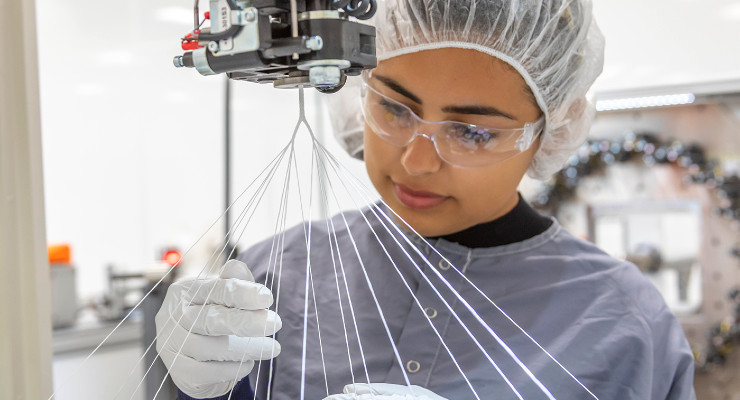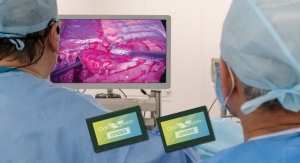Shanzeh Farooqui, Development Engineering Lead, Cortland Biomedical10.01.20
Modern medicine is trending significantly toward the pursuit of less invasive medical procedures. Minimally invasive approaches have the potential to significantly improve overall patient outcomes, as well as reduce costs to the healthcare system. Patients undergoing minimally invasive surgery (MIS) generally report less post-surgical pain and more rapid recovery times than those treated with traditional open surgeries. Additionally, the surgeons performing these MIS procedures often find them faster and easier to perform, requiring less OR time.
The development of smaller, lower profile medical devices has been essential to making less invasive surgical approaches feasible across a variety of healthcare applications and is important for keeping up with the growing demand for MIS. Medical device companies have been successful in their mission to bring devices to market that support MIS approaches in large part because of the incorporation of biomedical textile materials. Through partnerships with biomedical materials developers and medical textile manufacturers, OEMs have been able to design and commercialize devices across a broad range of specialties such as orthopedics, cardiology, tissue engineering, sports medicine, and general surgery that offer lower profiles without sacrificing strength and other key mechanical and biologic characteristics.
Today’s implantable medical fabrics have evolved to a point where they can offer an array of features and benefits—previously not possible—via the development of specialized structures by skilled textile engineers. By combining an understanding of textile production with medical science, textile engineers can create versatile implantable fabric structures using knitting, braiding, and weaving—customized to meet the needs of their medical device OEM partner.
For the construction of each fabric structure, there are dozens of variables such as materials selection, forming techniques, and manufacturing processes that should be considered to ensure the highest alignment toward the final device requirements. Medical textile product development partners should work closely with OEMs to ensure all documentation adequately describes the product performance required. Having a thorough understanding of the regulatory requirements, and adjusting their own operations in accordance to operate under the design and control guidance of ISO 13485, as well as putting strong quality management and validation processes in place helps finished devices make it to market more smoothly.
But not all medical textile product developers are able to add the same value for their OEM partners. Some are going the extra mile to consider the lesser regarded factors that can have a significant impact on a medical device’s path to regulatory approval and commercial launch. Following are examples of eight often-overlooked areas a medical textile developer should be thinking about so the OEM doesn’t have to.
1. Innovation: Not all development partners are willing to move outside their comfort zone and truly innovate when it comes to addressing complex textile challenges. Driven by an outdated business model, textile developers have long overlooked opportunities for innovation in favor of established, high-volume textile production. These practices have created a gap between user needs and market practices. There is an opportunity here to redefine a space ripe for innovation with a fresh business model aimed at closing the gap and breaking down barriers. The right combination of creativity, infrastructure, capabilities, and experience can lead to better products that expand the limits of what’s possible.
Your partner should be able to apply advanced expertise in biomedical textile engineering methods, including incorporating the latest in knitting, braiding, and weaving technology, to create a high-performance biomedical material structure. Choose a textile development partner that can take your product idea off the drawing board and make it a reality.
2. Cross-disciplinary teams: While it’s certainly essential to have a thorough understanding of textile engineering, this knowledge alone doesn’t always make for optimal products. Teams that combine engineers and specialists with expertise that ranges across textiles and medical device development bring a better understanding to every project of how the finished product will need to perform in the real world.
3. Rapid prototyping and iterative development: These play a vital role in facilitating effective design under a truncated timeline. By allowing OEMs to be actively involved in product development and conduct in-person trials, textile developers can get real-time feedback on prototypes and test results, allowing them to react quickly with changes as necessary. Rapid and iterative prototyping sessions can help to hone in on the most practical and utile design.
Textile developers should be open about their equipment capabilities and allow OEMs to have insight into the manufacturing process, which can lead to shorter development cycles and a better understanding between the developer and OEM. Inviting the OEM in to observe the manufacturing process in action can give them a more tangible understanding of the equipment and the requirements for manufacturing. Clear and frequent communication throughout the development process helps establish a true partnership and ensures the form, fit, and function of the final textile product meets the needs of the device.
Textile developers should be agile and nimble enough to handle several rounds of prototyping within one development run, creating multiple construction variations against one order to limit the amount of paperwork, back-and-forth, and approvals necessary to generate purchase orders.
Ultimately, through iterative development and closer collaboration, the OEM customer may end up with a sleeker and smaller profile textile construction than what was initially prototyped.
4. Cleanrooms: ISO Class 8 cleanrooms alone are no longer always enough to sufficiently support an OEM’s manufacturing plan. While fabric formation typically occurs in Class 8 cleanrooms, Class 7 cleanrooms are more suitable for assembly, cleaning, and post-processing. This is due to the criticality of these final processes and the impact they can have on microbial, cytotoxicity, and other biocompatibility characteristics. More medical device manufacturers are conducting the final assembly of critical components in these types of cleanrooms and paying specific attention to contact materials—even down to the type of sterile gloves that are worn—with their textile developer to reduce risk and eliminate potential contamination.
5. Contact surfaces: Attention to detail with every contact surface a textile component touches throughout the process is critical to preventing cross-contamination, which can have disastrous consequences. Ensuring everything from counter tops to roll coverings are made of medical-friendly material is necessary. Additionally, high-performance medical-grade fibers that are now widely used require special attention when it comes to contact surfaces. These fibers may lose some critical performance capabilities if treated poorly during processing. For example, a hard and smooth contact surface is likely to degrade the strength of certain yarns by shearing the individual filaments, ultimately compromising the mechanical strength of the final construct. Softer, high-surface area contact surfaces coupled with rolling surfaces will make the yarn much easier to process and eliminate any potential yarn fraying or breakage.
6. Water: If the water quality at your textile partner is not up to par, the integrity of the entire textile structure can be compromised. This concern can be successfully mitigated with a fully integrated water purification system for removing manufacturing finishes and lubricants. Almost all biomedical textiles must be cleaned or “scoured” to reduce the risk manufacturing lubricants pose. As such, an in-house system to process water that can meet the requirements of a recognized ASTM standard is critical. A full system validation including a functional OQ and PQ should be considered the norm. Ongoing monitoring of the system including routinely performing microbial and endotoxin testing on water taken from sanitary sampling ports is critical.
7. Packaging: Packaging may seem like an afterthought, however, implantable medical textiles come into direct contact with the human body and must be kept sterile prior to use. This necessitates due diligence on the selection of appropriate packaging materials as well as methods. Packaging requirements vary between products and application areas, so it must be made of materials that achieve the required level of protection against bacterial contamination—as well as factors such as light, moisture, etc. For example, BHT- and plasticizer-free packaging is becoming the norm for many medical device components due to the risk of harmful chemical exposure from those materials. Additionally, more delicate or reactive materials may need to be packaged in opaque foil pouches with an inert nitrogen gas as a buffer to protect the contents. Further, the packaging process should be carried out in a monitored clean environment to eliminate any particulate contamination risk.
8. Supply chain security: Having reliable supply chain partners can make or break a development product. Medical textile developers have many suppliers of their own whom they rely on to deliver high-quality materials critical to manufacturing. Strong relationships with material suppliers are extremely important in the development and validation processes. Having an open line of communication and a relationship built on trust and shared experience allows free flow of critical information necessary for product validation and regulatory approval.
In the medical device manufacturing industry, full traceability to raw materials and processes is critical. If your medical textile developer has strong relationships with their suppliers, it will guarantee not only continuity of supply but also may allow the OEM to have a say in how materials are processed, packaged, and delivered, allowing them to customize the supply process based on specific device and regulatory needs.
In conclusion, choosing a textile development partner that has given due consideration to both major and lesser regarded factors can result in a more successful collaboration. Concept, feasibility, and product development supported by an innovative, cross-functional team with an understanding of textile engineering, packaging expertise, and rapid prototyping can provide the speed and agility an OEM needs to shorten their development time. Furthermore, validation processes and regulatory submissions are better supported and de-risked by medical textile developers who have best-in-class control of their manufacturing and supply chain. Being aware of all the aforementioned factors can help prevent avoidable setbacks on the path to approval, enabling innovative devices to come to market without unexpected—and often costly—delays. Selection of the right medical textile partner just may be the difference.
Shanzeh Farooqui is an engineering leader experienced in medical device and component manufacturing. Her skills include R&D, business development, design control, and operations management.
The development of smaller, lower profile medical devices has been essential to making less invasive surgical approaches feasible across a variety of healthcare applications and is important for keeping up with the growing demand for MIS. Medical device companies have been successful in their mission to bring devices to market that support MIS approaches in large part because of the incorporation of biomedical textile materials. Through partnerships with biomedical materials developers and medical textile manufacturers, OEMs have been able to design and commercialize devices across a broad range of specialties such as orthopedics, cardiology, tissue engineering, sports medicine, and general surgery that offer lower profiles without sacrificing strength and other key mechanical and biologic characteristics.
Today’s implantable medical fabrics have evolved to a point where they can offer an array of features and benefits—previously not possible—via the development of specialized structures by skilled textile engineers. By combining an understanding of textile production with medical science, textile engineers can create versatile implantable fabric structures using knitting, braiding, and weaving—customized to meet the needs of their medical device OEM partner.
For the construction of each fabric structure, there are dozens of variables such as materials selection, forming techniques, and manufacturing processes that should be considered to ensure the highest alignment toward the final device requirements. Medical textile product development partners should work closely with OEMs to ensure all documentation adequately describes the product performance required. Having a thorough understanding of the regulatory requirements, and adjusting their own operations in accordance to operate under the design and control guidance of ISO 13485, as well as putting strong quality management and validation processes in place helps finished devices make it to market more smoothly.
But not all medical textile product developers are able to add the same value for their OEM partners. Some are going the extra mile to consider the lesser regarded factors that can have a significant impact on a medical device’s path to regulatory approval and commercial launch. Following are examples of eight often-overlooked areas a medical textile developer should be thinking about so the OEM doesn’t have to.
1. Innovation: Not all development partners are willing to move outside their comfort zone and truly innovate when it comes to addressing complex textile challenges. Driven by an outdated business model, textile developers have long overlooked opportunities for innovation in favor of established, high-volume textile production. These practices have created a gap between user needs and market practices. There is an opportunity here to redefine a space ripe for innovation with a fresh business model aimed at closing the gap and breaking down barriers. The right combination of creativity, infrastructure, capabilities, and experience can lead to better products that expand the limits of what’s possible.
Your partner should be able to apply advanced expertise in biomedical textile engineering methods, including incorporating the latest in knitting, braiding, and weaving technology, to create a high-performance biomedical material structure. Choose a textile development partner that can take your product idea off the drawing board and make it a reality.
2. Cross-disciplinary teams: While it’s certainly essential to have a thorough understanding of textile engineering, this knowledge alone doesn’t always make for optimal products. Teams that combine engineers and specialists with expertise that ranges across textiles and medical device development bring a better understanding to every project of how the finished product will need to perform in the real world.
3. Rapid prototyping and iterative development: These play a vital role in facilitating effective design under a truncated timeline. By allowing OEMs to be actively involved in product development and conduct in-person trials, textile developers can get real-time feedback on prototypes and test results, allowing them to react quickly with changes as necessary. Rapid and iterative prototyping sessions can help to hone in on the most practical and utile design.
Textile developers should be open about their equipment capabilities and allow OEMs to have insight into the manufacturing process, which can lead to shorter development cycles and a better understanding between the developer and OEM. Inviting the OEM in to observe the manufacturing process in action can give them a more tangible understanding of the equipment and the requirements for manufacturing. Clear and frequent communication throughout the development process helps establish a true partnership and ensures the form, fit, and function of the final textile product meets the needs of the device.
Textile developers should be agile and nimble enough to handle several rounds of prototyping within one development run, creating multiple construction variations against one order to limit the amount of paperwork, back-and-forth, and approvals necessary to generate purchase orders.
Ultimately, through iterative development and closer collaboration, the OEM customer may end up with a sleeker and smaller profile textile construction than what was initially prototyped.
4. Cleanrooms: ISO Class 8 cleanrooms alone are no longer always enough to sufficiently support an OEM’s manufacturing plan. While fabric formation typically occurs in Class 8 cleanrooms, Class 7 cleanrooms are more suitable for assembly, cleaning, and post-processing. This is due to the criticality of these final processes and the impact they can have on microbial, cytotoxicity, and other biocompatibility characteristics. More medical device manufacturers are conducting the final assembly of critical components in these types of cleanrooms and paying specific attention to contact materials—even down to the type of sterile gloves that are worn—with their textile developer to reduce risk and eliminate potential contamination.
5. Contact surfaces: Attention to detail with every contact surface a textile component touches throughout the process is critical to preventing cross-contamination, which can have disastrous consequences. Ensuring everything from counter tops to roll coverings are made of medical-friendly material is necessary. Additionally, high-performance medical-grade fibers that are now widely used require special attention when it comes to contact surfaces. These fibers may lose some critical performance capabilities if treated poorly during processing. For example, a hard and smooth contact surface is likely to degrade the strength of certain yarns by shearing the individual filaments, ultimately compromising the mechanical strength of the final construct. Softer, high-surface area contact surfaces coupled with rolling surfaces will make the yarn much easier to process and eliminate any potential yarn fraying or breakage.
6. Water: If the water quality at your textile partner is not up to par, the integrity of the entire textile structure can be compromised. This concern can be successfully mitigated with a fully integrated water purification system for removing manufacturing finishes and lubricants. Almost all biomedical textiles must be cleaned or “scoured” to reduce the risk manufacturing lubricants pose. As such, an in-house system to process water that can meet the requirements of a recognized ASTM standard is critical. A full system validation including a functional OQ and PQ should be considered the norm. Ongoing monitoring of the system including routinely performing microbial and endotoxin testing on water taken from sanitary sampling ports is critical.
7. Packaging: Packaging may seem like an afterthought, however, implantable medical textiles come into direct contact with the human body and must be kept sterile prior to use. This necessitates due diligence on the selection of appropriate packaging materials as well as methods. Packaging requirements vary between products and application areas, so it must be made of materials that achieve the required level of protection against bacterial contamination—as well as factors such as light, moisture, etc. For example, BHT- and plasticizer-free packaging is becoming the norm for many medical device components due to the risk of harmful chemical exposure from those materials. Additionally, more delicate or reactive materials may need to be packaged in opaque foil pouches with an inert nitrogen gas as a buffer to protect the contents. Further, the packaging process should be carried out in a monitored clean environment to eliminate any particulate contamination risk.
8. Supply chain security: Having reliable supply chain partners can make or break a development product. Medical textile developers have many suppliers of their own whom they rely on to deliver high-quality materials critical to manufacturing. Strong relationships with material suppliers are extremely important in the development and validation processes. Having an open line of communication and a relationship built on trust and shared experience allows free flow of critical information necessary for product validation and regulatory approval.
In the medical device manufacturing industry, full traceability to raw materials and processes is critical. If your medical textile developer has strong relationships with their suppliers, it will guarantee not only continuity of supply but also may allow the OEM to have a say in how materials are processed, packaged, and delivered, allowing them to customize the supply process based on specific device and regulatory needs.
In conclusion, choosing a textile development partner that has given due consideration to both major and lesser regarded factors can result in a more successful collaboration. Concept, feasibility, and product development supported by an innovative, cross-functional team with an understanding of textile engineering, packaging expertise, and rapid prototyping can provide the speed and agility an OEM needs to shorten their development time. Furthermore, validation processes and regulatory submissions are better supported and de-risked by medical textile developers who have best-in-class control of their manufacturing and supply chain. Being aware of all the aforementioned factors can help prevent avoidable setbacks on the path to approval, enabling innovative devices to come to market without unexpected—and often costly—delays. Selection of the right medical textile partner just may be the difference.
Shanzeh Farooqui is an engineering leader experienced in medical device and component manufacturing. Her skills include R&D, business development, design control, and operations management.



























